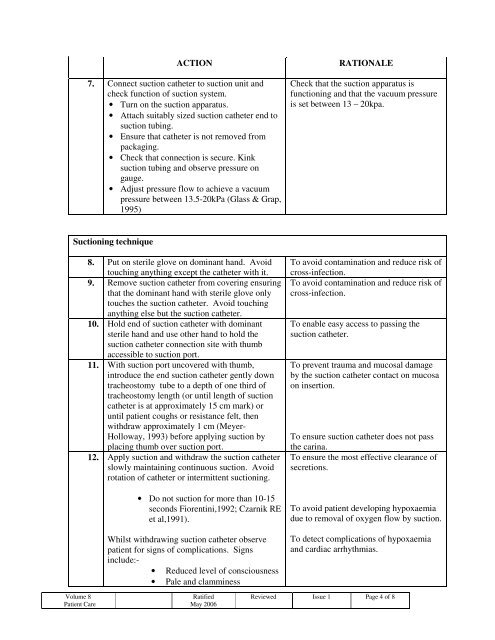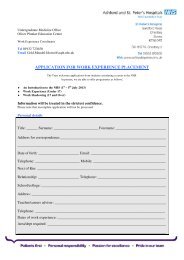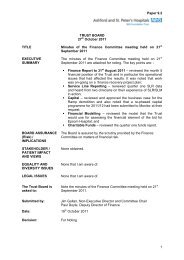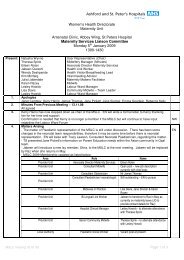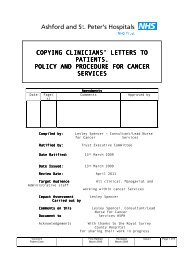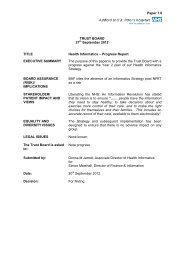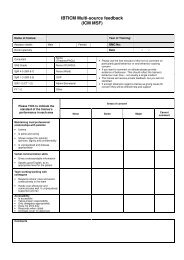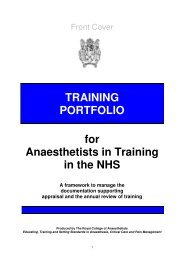Procedure for tracheal bronchial suctioning in adults.pdf
Procedure for tracheal bronchial suctioning in adults.pdf
Procedure for tracheal bronchial suctioning in adults.pdf
You also want an ePaper? Increase the reach of your titles
YUMPU automatically turns print PDFs into web optimized ePapers that Google loves.
Volume 8<br />
Patient Care<br />
ACTION<br />
7. Connect suction catheter to suction unit and<br />
check function of suction system.<br />
• Turn on the suction apparatus.<br />
• Attach suitably sized suction catheter end to<br />
suction tub<strong>in</strong>g.<br />
• Ensure that catheter is not removed from<br />
packag<strong>in</strong>g.<br />
• Check that connection is secure. K<strong>in</strong>k<br />
suction tub<strong>in</strong>g and observe pressure on<br />
gauge.<br />
• Adjust pressure flow to achieve a vacuum<br />
pressure between 13.5-20kPa (Glass & Grap,<br />
1995)<br />
Suction<strong>in</strong>g technique<br />
8. Put on sterile glove on dom<strong>in</strong>ant hand. Avoid<br />
touch<strong>in</strong>g anyth<strong>in</strong>g except the catheter with it.<br />
9. Remove suction catheter from cover<strong>in</strong>g ensur<strong>in</strong>g<br />
that the dom<strong>in</strong>ant hand with sterile glove only<br />
touches the suction catheter. Avoid touch<strong>in</strong>g<br />
anyth<strong>in</strong>g else but the suction catheter.<br />
10. Hold end of suction catheter with dom<strong>in</strong>ant<br />
sterile hand and use other hand to hold the<br />
suction catheter connection site with thumb<br />
accessible to suction port.<br />
11. With suction port uncovered with thumb,<br />
<strong>in</strong>troduce the end suction catheter gently down<br />
tracheostomy tube to a depth of one third of<br />
tracheostomy length (or until length of suction<br />
catheter is at approximately 15 cm mark) or<br />
until patient coughs or resistance felt, then<br />
withdraw approximately 1 cm (Meyer-<br />
Holloway, 1993) be<strong>for</strong>e apply<strong>in</strong>g suction by<br />
plac<strong>in</strong>g thumb over suction port.<br />
12. Apply suction and withdraw the suction catheter<br />
slowly ma<strong>in</strong>ta<strong>in</strong><strong>in</strong>g cont<strong>in</strong>uous suction. Avoid<br />
rotation of catheter or <strong>in</strong>termittent <strong>suction<strong>in</strong>g</strong>.<br />
• Do not suction <strong>for</strong> more than 10-15<br />
seconds Fiorent<strong>in</strong>i,1992; Czarnik RE<br />
et al,1991).<br />
Whilst withdraw<strong>in</strong>g suction catheter observe<br />
patient <strong>for</strong> signs of complications. Signs<br />
<strong>in</strong>clude:-<br />
• Reduced level of consciousness<br />
• Pale and clamm<strong>in</strong>ess<br />
Ratified<br />
May 2006<br />
RATIONALE<br />
Check that the suction apparatus is<br />
function<strong>in</strong>g and that the vacuum pressure<br />
is set between 13 – 20kpa.<br />
To avoid contam<strong>in</strong>ation and reduce risk of<br />
cross-<strong>in</strong>fection.<br />
To avoid contam<strong>in</strong>ation and reduce risk of<br />
cross-<strong>in</strong>fection.<br />
To enable easy access to pass<strong>in</strong>g the<br />
suction catheter.<br />
To prevent trauma and mucosal damage<br />
by the suction catheter contact on mucosa<br />
on <strong>in</strong>sertion.<br />
To ensure suction catheter does not pass<br />
the car<strong>in</strong>a.<br />
To ensure the most effective clearance of<br />
secretions.<br />
To avoid patient develop<strong>in</strong>g hypoxaemia<br />
due to removal of oxygen flow by suction.<br />
To detect complications of hypoxaemia<br />
and cardiac arrhythmias.<br />
Reviewed Issue 1 Page 4 of 8


